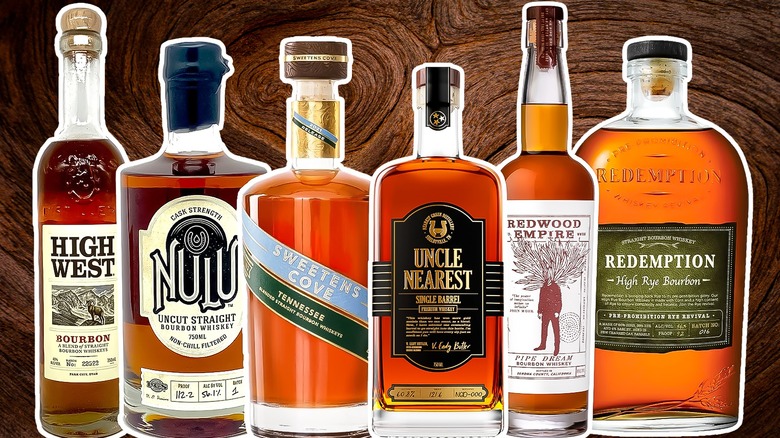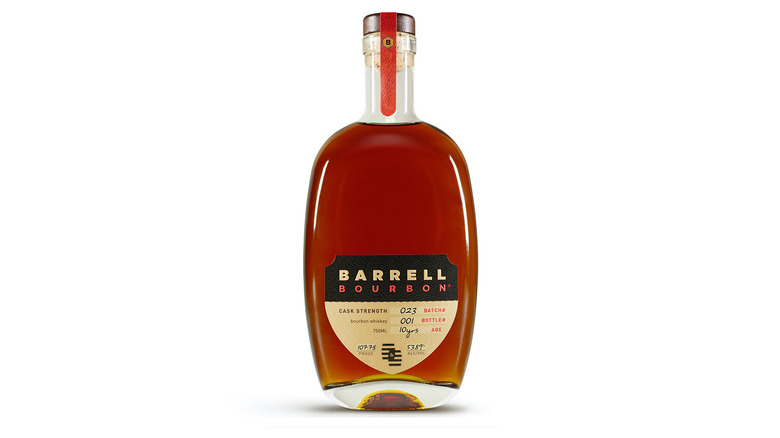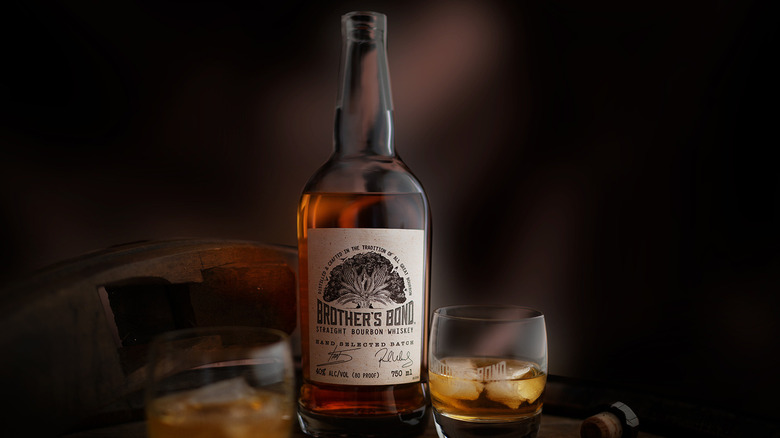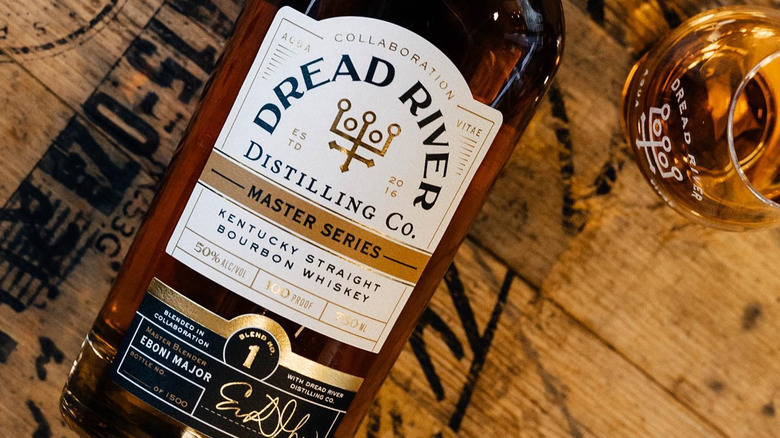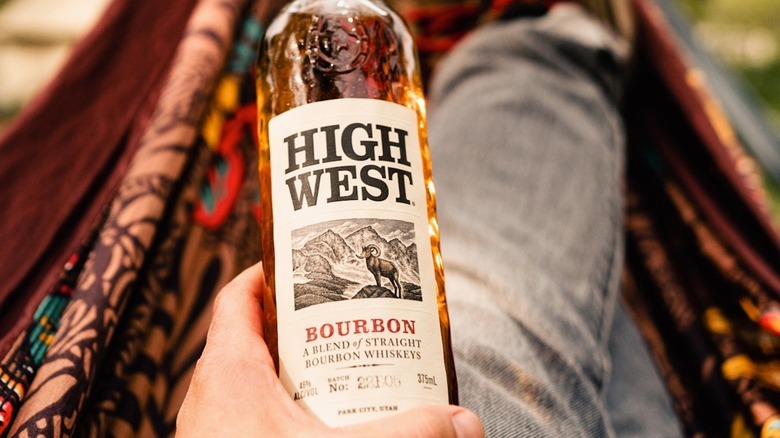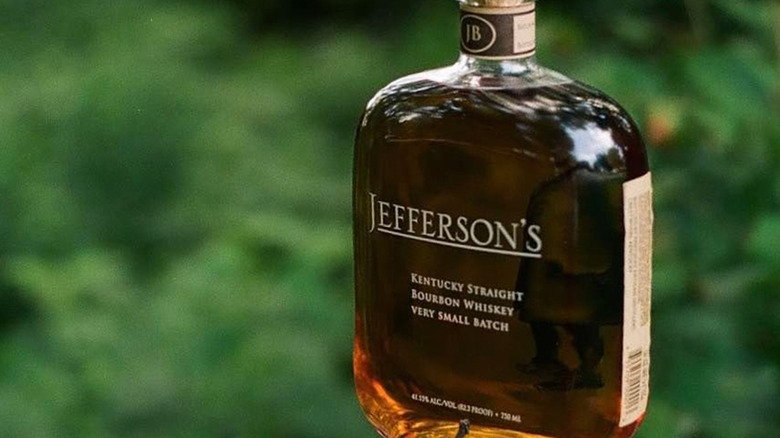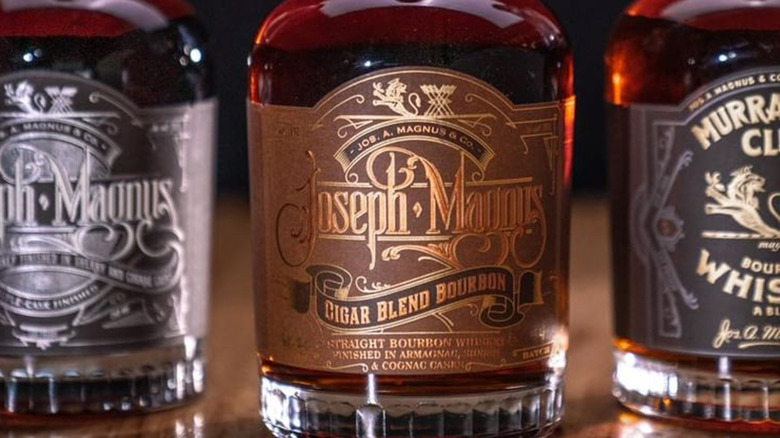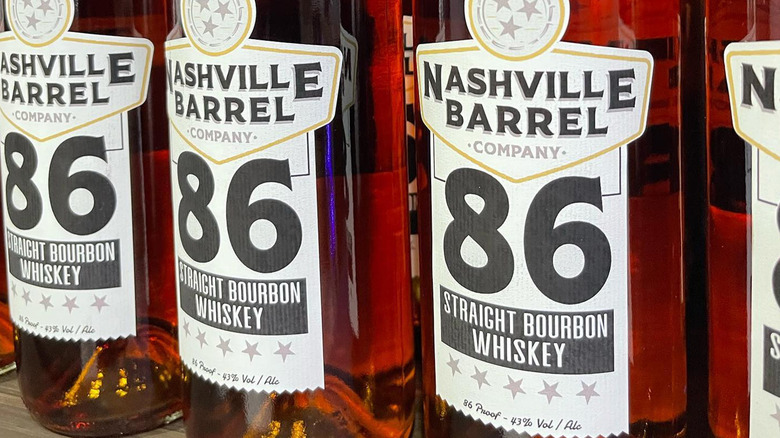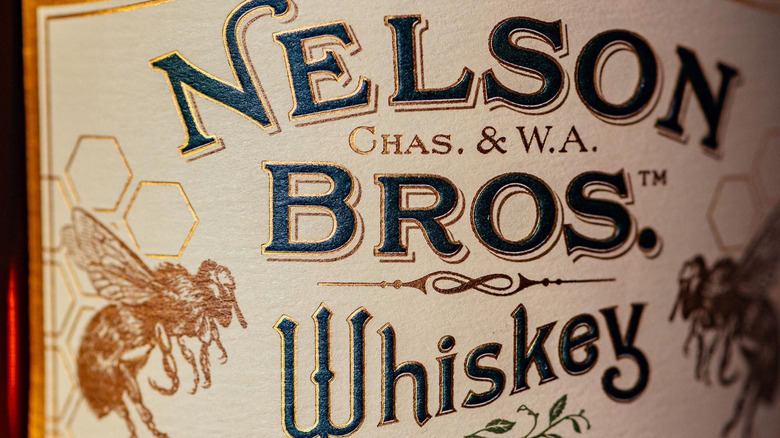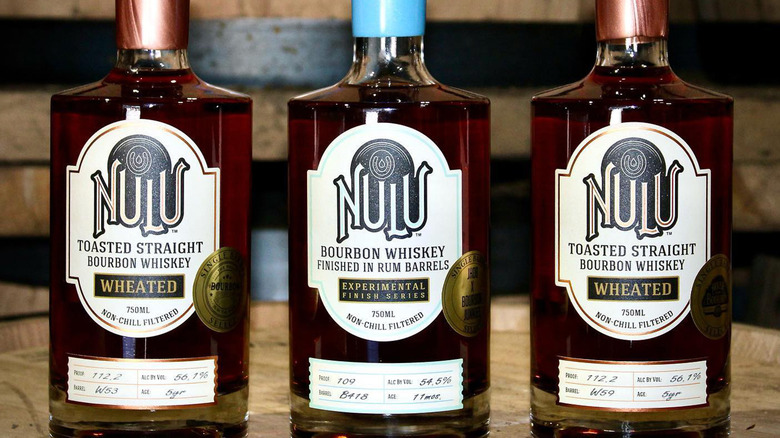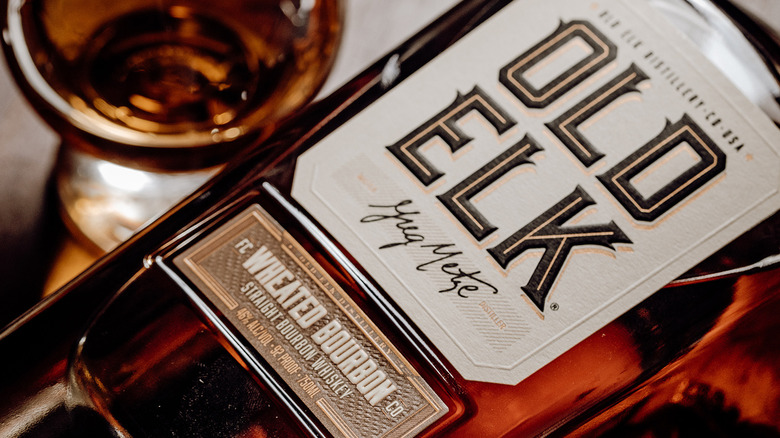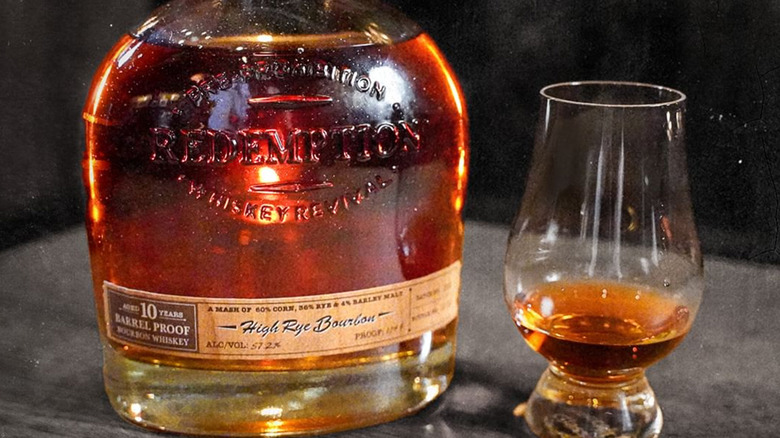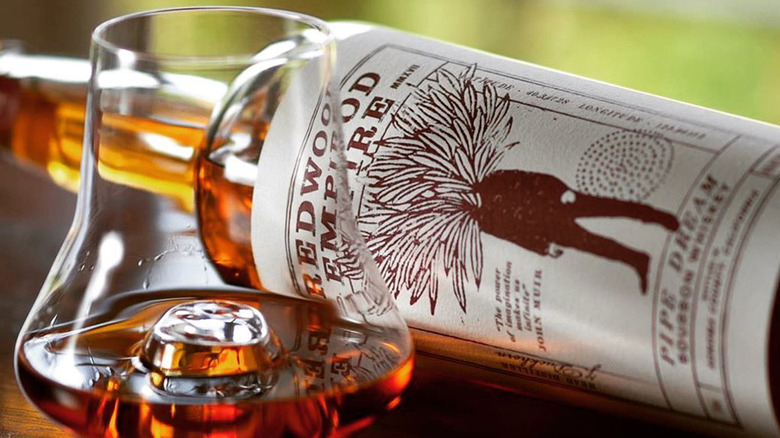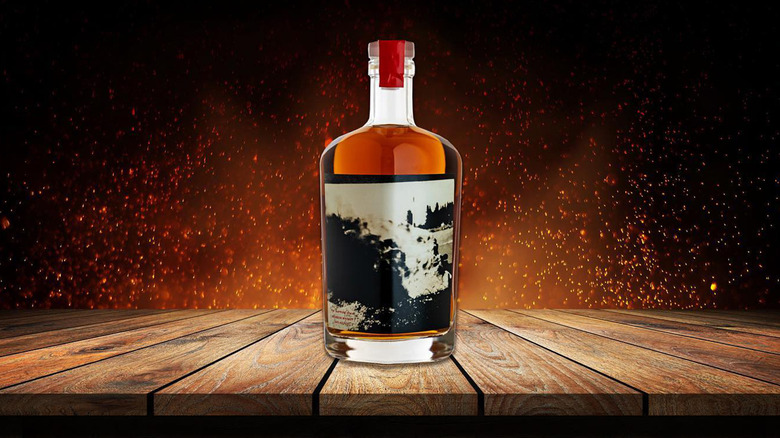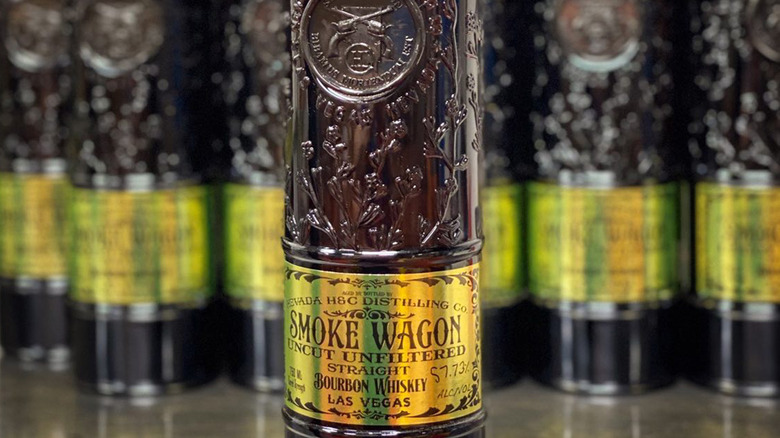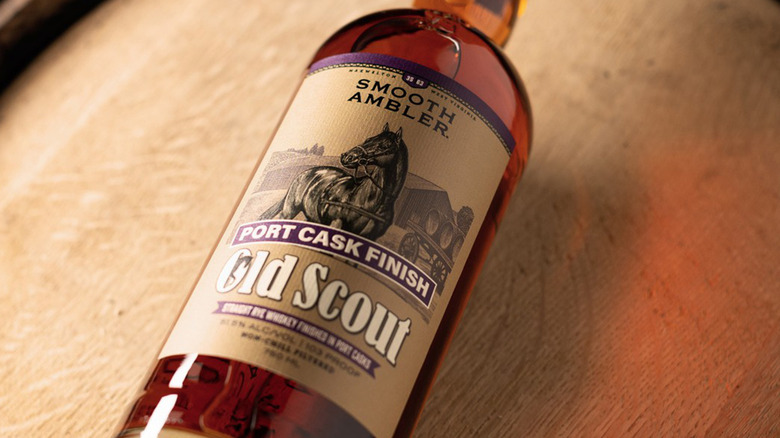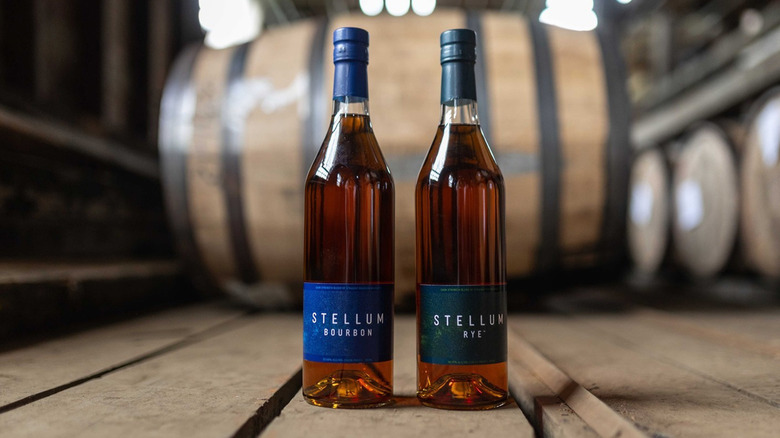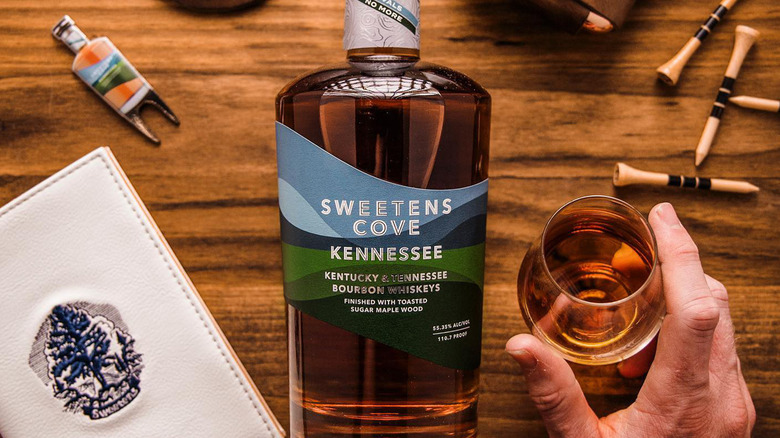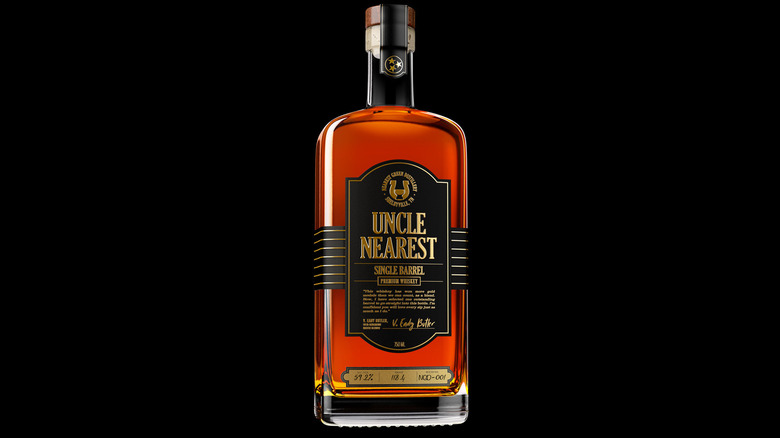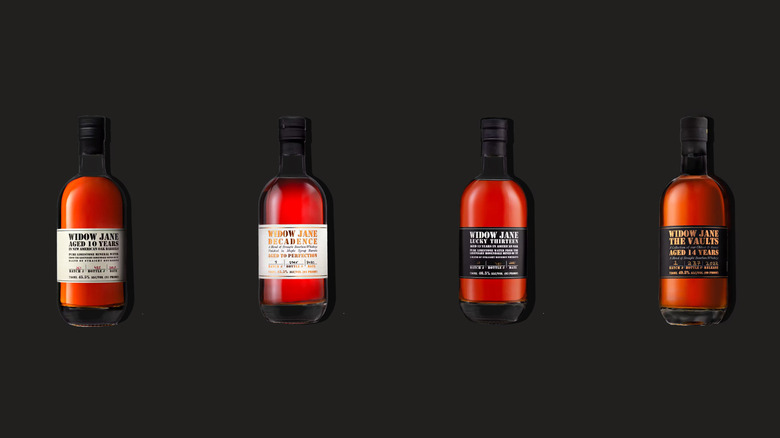19 Sourced Bourbons You Should Consider Trying
Deciding what exactly qualifies as a sourced bourbon is more challenging than it first appears. Is it something produced entirely at Midwest Grain Products, then bottled and labeled at your production plant? Is it an order of raw distillate that ages on your ancient family farm? Are you putting your potent small batch juice into a larger order that can absorb its strengths and smooth its weaknesses? Or maybe you're a team of master blenders who buy a whole bunch of completed rare cask bourbons and carefully create the proportionate mix of their best characteristics. Yes, those are all sourced bourbons, so let's not get precious about the broad definition.
Picking the best-sourced bourbons presents a similar challenge. Are we talking about an entire company, a brand, or a specific batch? Is it fair to put up the whole of one company's output against another's best champion?
To all of these, we say again: yes. If it's sourced bourbon, it's fair game for us to say "Hey, you should check this out." But to avoid one standout sweeping another distillery's whole career, or the weight of the latter vice versing the former, we're not ranking these. We're simply saying if you're not some bourbon purist out to deny yourself a world of great whiskeys, here, in alphabetical order, are some bottles for all budgets that you're going to want to pour.
Barrell Batch 023
You'd be hard-pressed to pick a better blend to kick off this list than Barrell's Batch 023, which sources from the three biggest bourbon-producing states — we assume. Come on, name a single possible contender — of Kentucky, Indiana, and Tennessee. While Barrell's whole lineup, often tilting to rye, draws praise, this one's a real standout that whiskey lovers still talk about three extremely eventful years of releases later.
The tough part's going to be finding Barrell Batch 023, since it's a highly regarded bottle of an often sought-after bourbon. But if you do, you're lucky to find it pretty close to MSRP, or at least the going rate for Barrell releases. It's not exactly a collectible so much as the recommended expression to try if you're looking to see what Barrell's whole deal is about. If the hunt isn't part of the fun for you, and you're okay with shipping fees, you can have it in hand soon as you like by buying a bottle on Drizly, but don't think too long about it. For $80-plus it's a low-risk gamble when the real hazard is that it might fall from stock while you're trying to convince yourself to buy another $40 familiar label. And if you do miss out, well, don't fret too hard. Batch 024 was a pip, too.
Brothers Bond
For the most part, whiskey enthusiasts are unpretentious. You could certainly think of more gatekeeping communities in the alcohol realm. Nevertheless, occasionally you need a perfect example to silence the snootier critics of sourced bourbon. That's Brother's Bond. Just a right-on whiskey that actually seems to earn its midway price point alongside Woodford Reserve and Buffalo Trace in the gut-reaction realm of "good bourbon" grunts and under $50. With the recent addition of a cask-strength, upscale becomes an option. However, as a newer offering, it lacks the market cognition those other two maintain, which made it one of our picks for the most underrated bourbons. Plus it's a four-grain, and there just aren't enough of those kicking around.
When a bottle is forthright about where it comes from rather than pretending to be some age-old tradition, you can stop worrying and enjoy it for what it is. Brother's Bond couldn't hide that if it wanted to, given that its founders met in well-documented circumstances working on "The Vampire Diaries." Its mandate is simply sharing a love of bourbon with a lifelong friend. And isn't that why we're pouring this bourbon in the first place?
Dread River Master Series 001: Eboni Major
There's more than one issue to take with Bulleit, but if you need a good one, Diageo's break with pioneering master blender Eboni Major, as reported by Gear Patrol, certainly raises both eyebrows. Even as her sourced Blender's Select was being hailed by critics, the production end had ripped apart, untenable.
Happily, the highly awarded and widely lauded Major found a new gig kicking off nascent producer Dread River Distilling Co.'s new Master Series in her hometown of Birmingham. Though the company is based in Alabama, Major blended Kentucky straight bourbon whiskeys from 2017 and 2019 to create this 2023 release that is still on pre-order, but reportedly tastes like a couple of fruit pies and a bit of oak. It must have felt like destiny for Major, whose grandmother lived adjacent to Dread River.
At least one bottle has made it into the wild or press hands, as a reviewer also found mint and tea in this well-positioned whiskey, which delivers nuance without tilting too hard in any direction calling it a triumphant debut for the series and a singlehanded success for Major. You know our take around here: we'll try anything once, and a 100-proof first. Good news for us and the whiskey world, then, that Major has lately gone into business with Marianne Eaves to curate the blind whiskey-tasting mail-order subscription service, EAVES BLIND.
High West
Utah seems like rough climate to make highly aged whiskey, but High West's biochemist founder is on top of it. While the whiskey maker does have its own still, and may not be fairly called a non-distilling producer, it also made a lot of its name on smart sourcing, and its single barrel selects really moved the Actually, its focus is rye with its flagship Rendezvous bottle, but that's somewhat eclipsed by its own special release, Midwinter's Night Dram. The annual event draws collectors like ants when it drops.
Bourbon-wise, there's one straightforward bottle using MGP distillate, and it always entertains, but you might actually find the best results picking up its Bourye (blended just as it sounds) or the more elevated take on the idea, The Prisoner's Share. Less premium on the price is the Campfire, which throws sourced scotch into the mix. Don't get us wrong; High West bourbon is a fine thing on its own. You just might find it worth getting familiar with as a Launchpad for blends beyond legal definition.
Jefferson's Ocean
Yeah yeah yeah, we know a lot of people think Jefferson's is a middling bourbon with a gimmick, but it's not a gimmick if it works. Whatever you think about the base, the finished product is briny and intriguing. You might not even like it. But it's different from anything else out there, and if a salty whiskey is indeed your thing, welcome aboard. Maybe we're biased in favor of the base anyway, but the great thing about the world is you don't owe anyone an account of your tastes. All we can do is articulate how warmly it resides on the tongue. There are a lot of sipping bourbons out there. Not nearly as many "sip-and-hold" ones, though.
Truth be told, picking a batch is hard, as these tend to vary quite a bit. So the dilemma becomes: group them all under the aged-at-sea banner and its saline qualities, or name the one that entrances the most after absorbing the properties of its unique voyage? We went with the former because each outing is a new adventure. If one is preferable to another, well, at least now you know after trying something new. That's the real spirit of what Jefferson's Ocean sells.
Though it may not remain on this list forever. Like many of the bourbons here, Jefferson's is moving towards independent production with its acquisition of Kentucky Artisan Distillery.
Joseph A. Magnus
Drinkers speak of the Cigar Blend like you can divide their lives into before and after, but don't let it eclipse the Sherry & Cognac Finish straight bourbon or the Murray Hill Club. The former passes through three different barrels that formerly housed fortified wines. The nose on this recently revived brand is one of the most exceptional in bourbon's aromatic landscape. After a fruity explosion, it pivots smoothly but wide into herbs and spices.
Rich with nuance, and far from overpowering despite coming out cask strength, it's a safe target for someone looking to enjoy a really elevated bourbon without dipping into the three-figure realm that often gambles hard between worth every penny and severe disappointment. The fact that your friends may not have heard of it is only going to further impress them when you bring it out for their enjoyment. They'll enter with no expectations and leave with only delightful discoveries.
Nashville Barrel Co.
Nashville Barrel isn't just upfront about sourcing its whiskey; it boasts about how many sources it rejects. It's a company devoted to tracking down the best barrels out there, and then getting them on your palate at a fair price. Like evangelists of an entirely different kind of spirit, Nashville Barrel Co. just wants everyone to be able to enjoy great whiskey as much as its founders do. (Rum's also on the menu, if you're feeling tiki.) Single-barrel is the focus, but it also blends cask-strength bourbons and offers a single-hive, single-barrel, cask-strength release as well, which ... is single-hive a thing? Regardless, it shows what you can expect from this Tennessee distillery: a single-barrel single-mindedness tempered only by asking "How can we make these good barrels into something new and great?"
The company founders realized allocated bourbons were moving rapidly from value-bringers at favored shops to golden handcuffs too escalatory to ever sell, or else hunted to extinction in short order. Nashville Bourbon Co. resolved to get there first. NBC (yes, it does refer to itself as such) began hunting the next great thing and found so many great single barrels, that a year later created its own rickhouse to age them. Not a bad start for a company that launched in our collectively final non-nail-biting month, February 2020.
Nelson Bros. Honey Cask
You might have heard that you ought to pick this one up under its previous name of Belle Meade Honey Cask. Bourbon Culture explains that Belle Meade and Nelson's Green Brier were two separate whiskey brands — the former sourced, the latter distilled in-house — being made at the same site. Belle Meade got all the fame and glory for its honey cask, which sounds like some kind of annual master distiller's pick of the best barrel in the bunch. It is not. It's quite literally a cask that previously held local honey and then bourbon, and we can all agree that honey and bourbon are a beautiful pairing. The market agreed, and these high-scoring, small releases became one of those frenzied gatherings of a particular type of whiskey nerd who, infuriatingly, was absolutely right in spite, and because, of himself.
From there it gets convoluted. Fast forward: the honey cask concept bounced between the two brands around the same time that the source seemingly switched from MGP to, or with, Bardstown Bourbon. And possibly there's still some in-house wheated NGB in there? Or not? Gracious, it is a confusing situation, whose Gordian knot is seemingly sliced by the new label of Nelson Bros. in last year's release. But of course, the fans are unhappy with price hikes and quality control, and all we know is, if you soak bourbon in honey wood, we're going to turn up to try it. That's one thing that hasn't changed.
NULU
NULU's an odd label that could be either agave spirit aged in bourbon barrels or MGP-sourced bourbon that will eventually be replaced with in-house distillate. Like Nashville Barrel Co., Prohibition Craft Spirits has made a business of sourcing top-pick single barrels, and the plum pick just may be this one, finished for 13 days in an Amburana barrel.
Amburana wood (also called cerejeira) comes from Brazil, where this strain of oak has very desirable properties. The distilling and brewing worlds have lately discovered and come to love the cinnamon spiciness that it imbues in booze. This might be considered a game-ending advantage, but if the honey cask wasn't a cheat, why should the use of a rare oak be?
But it's not so simple as "This wood's taste is good in bourbon." Northeast Barrel Company explains that the wood contributes to more congeners, i.e. maturation compounds, for deeper and more complex flavors. Everybody wins (except the Brazilian forest) with the addition of an Amburana cask finish, or barring that, tossing in a spiral-cut dowel. For drinkers, there's a novel and pleasing taste. For distillers, they can create a more intriguing depth without having to wait 10 years. Just don't go crazy. Congeners have also been linked to worse hangovers, although it's admittedly a very broad chemical category.
Old Elk Wheated
Old Elk is rapidly mutating with its Master's Blend series and its Infinity Blend, an escalating all-batches project. And of course, there's its three-state Blended, the Four Grain bottle, the single barrel program, the wheat whiskey, the cask finish series, and probably a dozen we missed.
But for all those options, the proud sourcer in Colorado's growing whiskey scene still gets our vote with the wheated bourbon out of its core four. Maybe it's because Old Elk's made wheat such a big part of its market exploration, including the aforementioned wheat whiskey's 95% wheat mash bill. The bourbon counters expectations with a rare nose that has a fruity earthiness, like mango or papaya, then bounds into tastes of salt and pepper before finishing big and oaky. Swig it, and it turns into cake. Chew it, it brings back the mint of the nose. A strange polymorph, this one.
Old Elk's sources are murky, but for sure include MGP distillate. Old Elk's master distiller Greg Metze has four decades of expertise in not just this scene but specifically at Indiana's Seagram's distillery, which eventually fell into MGP hands. Metze is a fan of slow proofing to protect the whiskey's volatile compounds, something we also saw employed to great effect in Still Austin. If that notion grabs you, then you can safely double down on the Double Wheat with only half the risk.
Redemption
Redemption doesn't obscure its MGP roots. There's no illusion or pretension here, just comfort and relaxation. The solid, all-purpose line wants to be the equivalent of the jeans you don't mind staining, the car you drive on errands, the weathered multitool in your pocket. It does many things to your satisfaction more than one thing to elite levels ... generally.
Then, sometimes, a great barrel comes along that just has to be set aside for the brand's high-rye, single-barrel program. Free from diminishment by chill filtration bottled up at a brawny 105 proof, these bottles embody Redemption's all-around utility at its peak. You get all that for another $10 up on the going rate for the others.
Of course, there's also the wheated bourbon if you want to spend a little more, but almost every reviewer out there favors the significantly lower-priced single barrel over the ultra-wheated mash bill's results. And isn't it always nice when the better deal wins on both price and flavor simultaneously?
Redwood Empire Pipe Dream
Redwood Empire is like your cool favorite band's cool favorite band. Everybody loves The Clash; not everybody digs on Mott the Hoople. The whiskey core fandom is always comparing the exceedingly different expressions that seem more like somebody in California is creating an art series than they are putting out a drinkable product. Maybe it's all the surrealist labels, but if there was such a thing as the perfect whiskey to drink as you emerge from a late-afternoon nap, it's this dreamy brand, though it's for sure sent a few people into one.
Because they're so different, we're tuning in on the one we've tried in person: Pipe Dream is sweet and spicy and just bitter enough to suggest bark without spoiling anything, thanks to that sugary cushion. This is another bourbon where it's so good you think it outclasses much of its competition for the price point, then you discover that you've dramatically overestimated the sticker. If you want a $45 bourbon that drinks like a $60 bourbon for $35, congratulations, you just won at both ends of the transaction with this California craft bottle.
Savage & Cooke The Burning Chair
With a name like Savage & Cooke The Burning Chair Bourbon and its austere, old photo for a label, you would quickly guess this is some ultra-smoky high-proof whose only filter is the number of people who can't handle its intensity. What you get instead is an elegant blend of at least one young bourbon (age statements can only cite the youngest in the mix, so we know one is four years) and mystery ones, gathered from Kentucky, Indiana, and Tennessee.
After a finish in the brand's own cabernet barrels, it's cut to one of the lower proofs out there at 88, and bottled up to wow you the drinker with its unique blend of flavors not only seldom combined, but rarely witnessed in a bottle of bourbon. Sweet and herbaceous seems to be the consensus, though not in the so-often-seen fruity pathway of cherries and lemons. Drinkhacker finds such comforting notes as eucalyptus, chai tea, and marshmallow keeping it chill against the initially expected cantankerous gunpowder and tobacco. The result is unlike anything else out there.
Smoke Wagon
Nevada Distilling appears to be headed towards vertical production, as it actually prompted the city of Las Vegas to create new governance regarding alcohol distillation with the company's formation. As recently as last year, they were still blending and releasing the MGP stuff.
As with Savage & Cooke, you can easily lead yourself into expecting some sun-boiled butt-kicker behind the embossed medallions of twin pistols that give Smoke Wagon its name. And as with The Burning Chair, what you get instead is a four-year, high-rye blend that's consistently light. The unfiltered Smoke Wagon bends floral and creamy, though it does show evidence of the Southwest climate roiling its barrels.
Picking a specific Smoke Wagon was always going to be the challenge for this entry. The company currently has four core bourbon blends on offer, though you may want to start with Uncut the Younger and wade into deeper waters from there.
Smooth Ambler
Widely respected and regarded as one of the canniest sourcers and blenders in the game, West Virginia's Smooth Ambler draws regular praise. Its blended (or mingled, according to the brand) Contradiction appears to be at least partially homemade, as the distillery releases its own cask strength bottles, blended in Contradiction with MGP and an undisclosed Tennessee distiller that, as is frequently the case, seems to be George Dickel, which also gave us some of Eboni Major's finest Bulleit work, and is a Barrell mainstay.
The sourced ("procured") Old Scout is often one of these two distilleries as well, carefully chosen from the stocks and kept as it is. Drinkers run kind of hot and cold on Old Scout knowing that it will never again be those 13-year stores of George Dickel scooped up cheap, but continue to show faith in Old Scout to find something quality to replace it.
So let us give you a tip: Old Scout is often best tasted at the bar so you know which batch you're getting into. But if you want to take a bottle home, find a great liquor store, pull up your eyelids, and scan for the six-year allocated store picks. These single barrels are expertly curated and wisely selected, usually under $50, and deliver that extra year of oomph that reviewers often wish for from the regular stock when it underwhelms.
Stellum
Another three-state selection from the united bourbon republic of Kentendiana, though the bottle does lean towards MGP. Stellum might be the newest whiskey on this list. It launched in 2021, an offshoot of Barrell, who's consistently at the top of this sourcing game.
So why isn't it coming out under a Barrell label? Well, it might just be a question of enough variables for unity in branding. Barrell releases strive for nuance and complexity. Stellum appears to be aiming for an arrow-shot simplicity that, rather than unifying differences, picks one aspect and goes for it directly. It's an efficiency and economy project that asks how good a whiskey you could make at how low a price if you focus firmly on the most effective points of production.
The result is half the price but not half the quality, and where Barrell charges ahead to make it, drink it, learn from it, and try something new, Stellum appears to be settling into a consistent gait. To put it briefly: order Barrell to experiment and don't get too attached. Order Stellum for reliability throughout the years.
Sweetens Cove
Every Sweetens Cove discussion online begins with the "rich guy golf course" or "Peyton Manning celebrity gimmick" disaparager learning the error of his ways as someone more knowledgeable says it's very satisfying. Credit the great reviews to Marianne Eaves (she of the EAVES BLIND tasting above). With savvy blending, discriminating barrel-finish selection, and a considerable 13-year age statement on the 2020 release (though it'll cost you), Sweetens Cove silences its doubters. The annual releases know their worth and charge rich-guy Peyton Manning money, but you can grab a handle of Kennessee, the Kentucky/Tennessee blend, for about $60 and see if you like the magic being cast under the cap.
Reports say this is another Dickel discovery, which is to the Tennessee distillery (not to be conflated with Tennessee Distilling Group)'s credit as the powerhouse behind a lot of great brands. While some people dislike the slightly metallic under-tang of Dickel product (described across the internet as "that Flintstones vitamin taste") there's no denying that the quality is there even if it's not your particular taste. However, scuttlebutt says Dickel may start holding onto all that good stuff for itself to build up its brand, so change could be in the wind.
Uncle Nearest Single Barrel
Is it weirder that the best mint julep whiskey out there might come from Tennessee instead of Kentucky, or that it's a bourbon made in memoriam of the guy who trained Jack Daniel to make the world's most famous "don't call it bourbon"? The original edition has a light flavor perfect for a warm hour unwinding. But the single barrel kicks with leather boots, all Saturday night instead of Sunday evening, much more in the fire and char realm of the Jack tradition.
A lot of early speculation said that Nearest was sourcing from Dickel, but the community has settled into the belief that it's actually TDG. In either case, don't expect to see Uncle Nearest on this list after a few more updates, because it won't be sourced for much longer. The brand exploded onto the scene making all the good waves, scored some top awards (including the all-important Tasting Table designation of best American whiskeys) for its product and master distiller Fawn Weaver, and reinvested all those earnings into making its own product. It's plain to see that Uncle Nearest has big plans for some dynastic expansion, and to that we say: good, since there's a mission to restore history as well as the future in this rocket-launch venture.
Widow Jane
Yep, New York City has distilleries, although more accurately, it has a non-distilling producer in Brooklyn's Widow Jane. The Red Hook rickhouse's whole deal is keeping the proof in the double digits and using limestone water from upstate to give its bourbon that same quality found in Kentucky and Indiana. So it's not just the distillate being sourced, but the water that's cutting it.
And to be honest, we could probably take or leave the gambles of the regular edition, whose price tag charges New York City rent for Indiana occupancy (along with Tennessee and Kentucky). But taken as a lineup, Widow Jane is back in the game. We'd push over our own widowed grandma (it's okay, she's dead too) to get at Decadence, which does the same sweetened barrel finishing trick as Nelson Bros. Honey Cask, but with maple syrup. The genteel Lucky Thirteen, aged 13 years impresses even naysayers (hey, that's us! We admit it!) as does The Vaults, aged 14 years, with its long-trail taste for urban cowboys.
And we go big on corn varietals like Bloody Butcher, Wapsie Valley, and Hopi Blue in the mash bills. The strain of the grain has a big influence, as seen in the recent drop of Daniel Weller Emmer Wheat. But few distillers can say they have their own breed of corn like the Baby Jane, and that's a level of effort we can respect and enjoy.
